Introduction
In an increasingly complex technological landscape, configuration management has emerged as a cornerstone for organizational success, ensuring that systems and their components are meticulously configured, maintained, and documented. This structured process is essential for maintaining system reliability and security, as it enables organizations to effectively manage changes across software, hardware, and documentation.
As industry leaders such as Amazon Web Services and Microsoft demonstrate, robust configuration management practices not only enhance service delivery but also drive significant operational efficiencies and cost savings. As organizations navigate the challenges of digital transformation, embracing best practices in configuration management becomes paramount.
This article delves into the critical aspects of configuration management, exploring its importance, best practices, the role of automation, integration with DevOps, challenges in implementation, and metrics for success, providing a comprehensive guide for organizations aiming to thrive in this dynamic environment.
Understanding Configuration Management: Definition and Importance
Configuration oversight serves as a vital process in ensuring that configuration management products accurately configure, maintain, and document systems and their components. This systematic approach involves the use of configuration management products for meticulous tracking and control of changes across software, hardware, and documentation within an entity's IT framework. The importance of system organization is profound; it fundamentally supports system reliability and security.
By utilizing configuration management products for effective setup oversight, organizations can significantly decrease downtime and operational hazards, while ensuring compliance with industry standards and regulations.
Swasti Dharmadhikari emphasizes that the growing use of configuration management products can be linked to several benefits, such as significant cost savings from reduced duplication of effort and faster problem resolution, which enhances service quality. Firms like Amazon Web Services, Microsoft, Oracle, and VMware illustrate how strong system organization practices can result in improved service delivery and customer satisfaction. For example, these industry leaders utilize system organization to quickly detect and correct discrepancies, thus not only preserving high service quality but also enabling digital transformation efforts that are essential in today's rapid technological environment.
Moreover, cloud-native technologies like Kubernetes and Docker natively support configuration management products, which facilitate easier adoption and implementation of these practices, leading to improved operational efficiency. Furthermore, Oracle Corporation's financial results highlight the significance of efficient system setup through configuration management products in enhancing business outcomes, as entities that adopt these practices can experience considerable advancements in their service delivery and overall financial well-being. Recent advancements in service level customization choices, including quarterly and annual report updates and dedicated research analyst support, further emphasize the changing environment of setup best practices, ensuring that entities remain up-to-date and competitive.
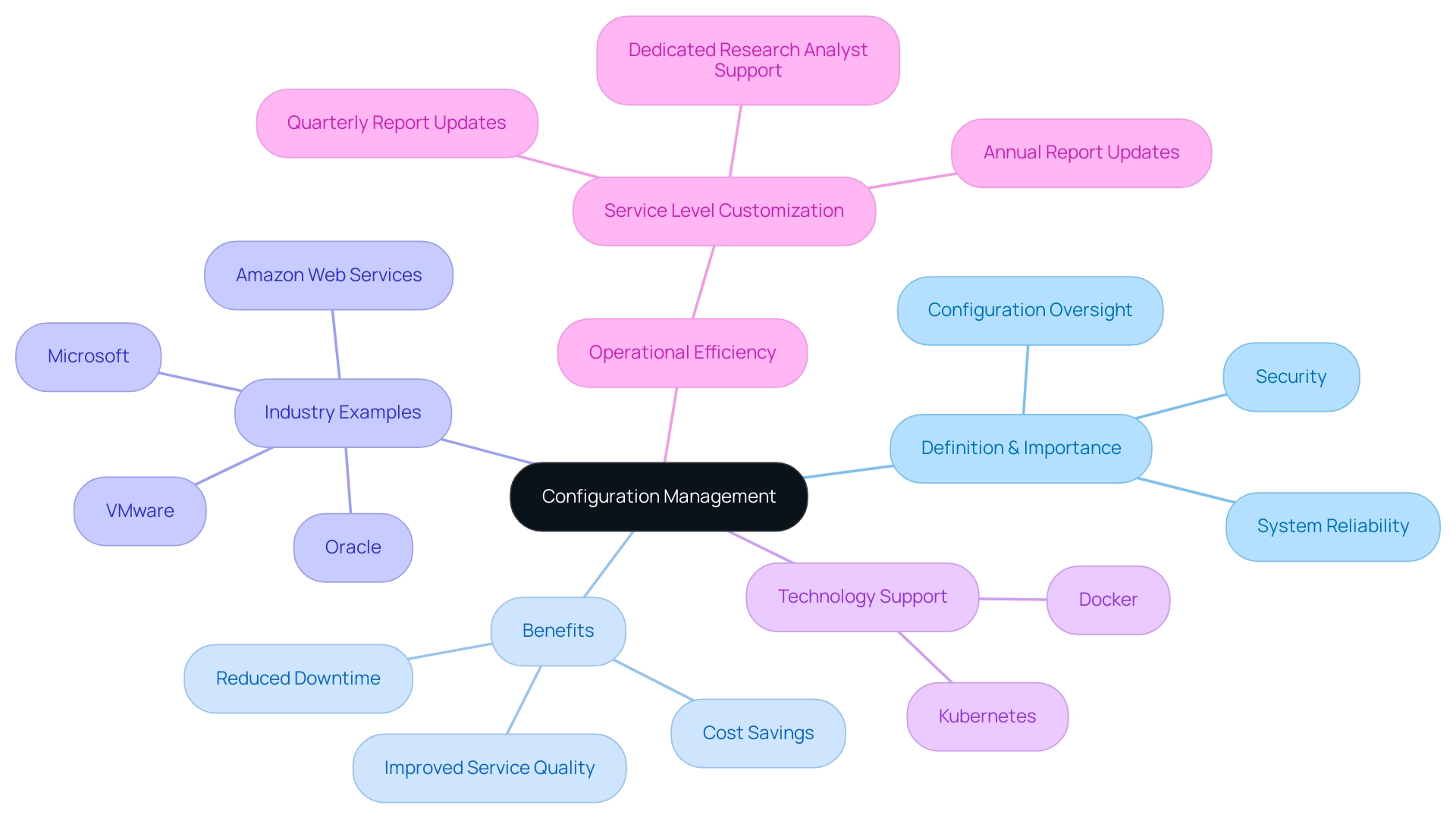
Best Practices for Effective Configuration Management: Expert Tips
To implement effective system organization, entities should adopt the following best practices:
-
Establish a Clear Management Policy: Formulate a comprehensive policy that delineates roles, responsibilities, and processes for managing setups. This policy should be closely aligned with overarching business objectives and regulatory requirements, serving as a foundational reference for audit preparations. A well-defined CMP not only streamlines the audit process but also ensures thorough reviews by providing auditors with structured documentation.
-
Utilize Automation Tools: Leverage leading setup management tools such as Ansible, Puppet, or Chef to automate repetitive tasks. By doing so, organizations can ensure consistency, minimize human error, and enhance agility when responding to developments. Automation not only accelerates recovery processes but also significantly contributes to operational efficiency.
-
Maintain Precise Documentation: Commit to regularly updating documentation related to system setups, modifications, and compliance obligations. Accurate documentation is critical; it not only facilitates audits but also ensures that all team members are equipped with the latest information, promoting transparency and collaboration.
-
Implement Control Procedures: Establish a formal control process that mandates the review and approval of modifications prior to implementation. This organized method reduces risks linked to unauthorized modifications and unexpected adjustments, protecting the integrity of system oversight. A standardized change management process is essential for assessing risks and validating changes, ensuring that all modifications align with organizational goals.
-
Conduct Regular Audits and Reviews: Schedule periodic audits to evaluate setup settings, compliance, and adherence to established policies. These audits are essential in pinpointing areas for enhancement and ensuring that setups remain aligned with evolving business needs. Such diligence is particularly crucial, especially in a landscape where cybercrime affected over 53 million people in the US in the first half of 2023.
-
Train and Educate Staff: Invest in comprehensive training programs aimed at empowering personnel involved in management processes. A well-informed team is essential for maintaining effective practices and adapting to technological advancements. As Ran Cohen, CTO & Co-Founder, emphasizes,
Maintain versioning of settings: Use version control systems to manage setups, much like code. This allows for easy tracking of changes, detailed auditing, and rollback capabilities, as well as collaboration across teams.
-
Embrace Infrastructure as Code (IAC): Implement Infrastructure as Code (IAC) practices to manage IT infrastructure through machine-readable files. This approach not only enables version control and automation but also guarantees consistency and reproducibility in setup. By adopting IaC, entities can improve collaboration and simplify their setup processes.
By embracing these best practices, entities can significantly enhance their setup oversight processes, leading to improved operational efficiency, reduced risks, and better alignment with strategic business goals.
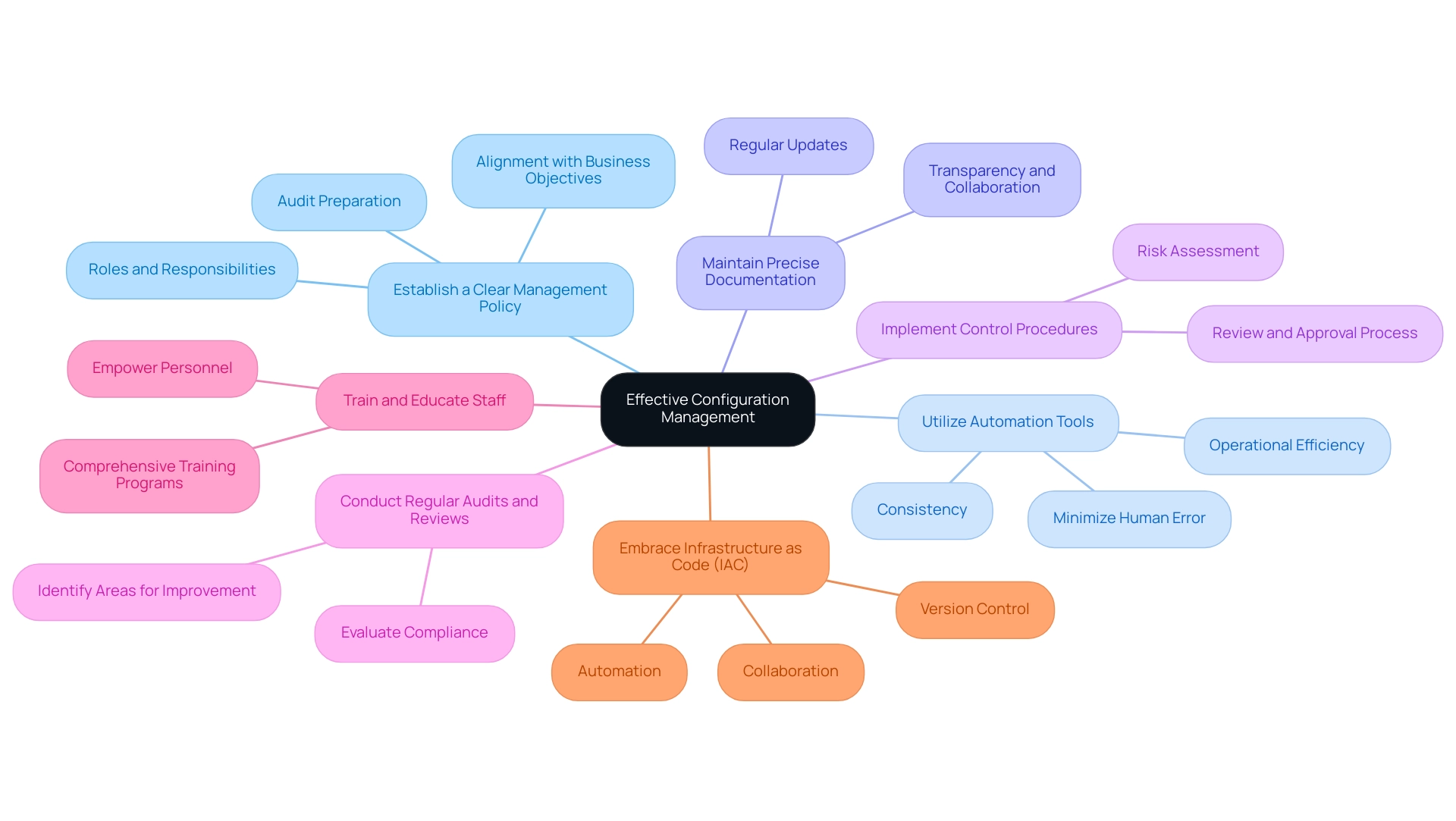
The Role of Automation in Configuration Management
Automation has emerged as a crucial influence in system setup, drastically reducing both the time and effort needed to oversee complex IT environments. By utilizing automation tools, companies can improve their setup processes, ensuring compliance, accelerating change deployments, and enabling thorough system monitoring. For example, Terraform is recognized as a premier tool for the automated provisioning and management of infrastructure, enabling organizations to uphold uniform setups that comply with established standards.
Moreover, automation significantly reduces the incidence of human error, a primary contributor to variation drift. The implementation of automated scripts for setup tasks not only leads to more reliable and predictable outcomes but also enhances overall operational efficiency. As we approach 2024, it is imperative for organizations, particularly the 10,533 companies employing between 250 to 499 individuals, to continuously assess and incorporate new automation technologies.
This proactive approach is essential for maintaining a competitive edge in the use of configuration management products amidst evolving market demands. As one expert noted, 'Facing client demands for contract changes can be challenging. Discover strategies to manage renegotiations effectively while maintaining professional boundaries.'
This insight is particularly relevant in high-stakes scenarios, such as contract renegotiations, where stakeholder emotions can run high. Furthermore, case studies like 'Managing High Emotions During Contract Negotiations' illustrate the importance of maintaining focus and professionalism to keep negotiations on track. Embracing automation is not merely a trend; it's a strategic necessity for organizations aiming to thrive in the competitive landscape of IT.
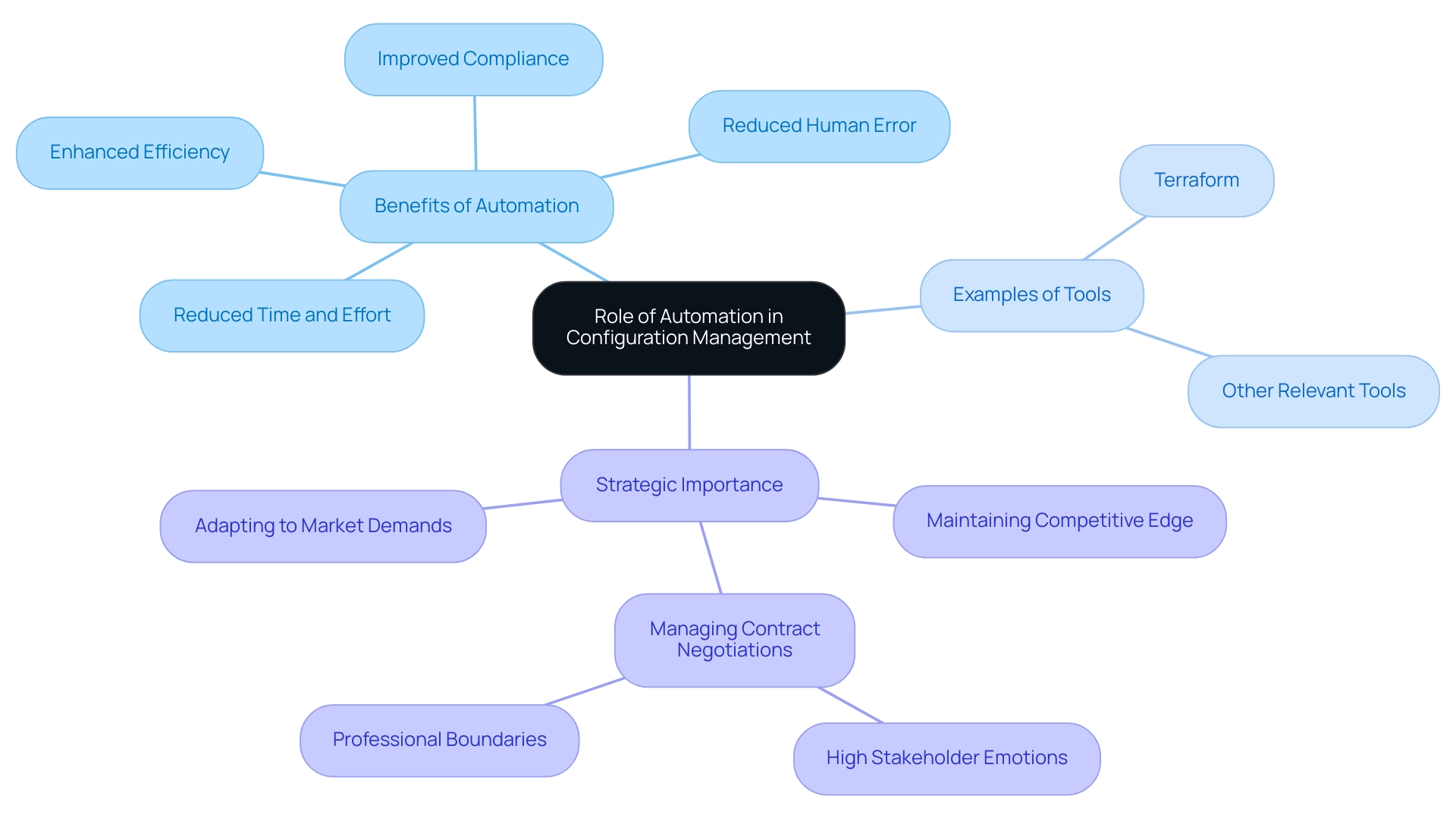
Integrating Configuration Management with DevOps Practices
Incorporating setup oversight within a DevOps framework is essential for fostering a culture of teamwork and ongoing enhancement. Configuration management products not only ensure consistency and reliability in environments characterized by rapid deployment and frequent updates but also facilitate the implementation of infrastructure as code (IAC). This practice enables teams to handle setups through code, which offers significant benefits such as:
- Version control
- Automated testing
- Seamless rollbacks in the event of errors
A practical example of this is Kubernetes, which has been adopted by over 50% of Fortune 100 companies, illustrating its capability to support automation, scalability, and resilience in DevOps workflows. As a result, this method improves collaboration between development and operations teams, allowing them to function from unified setup definitions and reducing miscommunication. As a result, entities that embrace this integrated methodology are likely to experience accelerated release cycles and enhanced system reliability—key factors for maintaining a competitive edge in today’s dynamic digital landscape.
Furthermore, with the demand for DevOps specialists increasing, as evidenced by a 75% rise in job postings on Indeed, the urgency to adopt such practices has never been more critical. As one industry expert pointed out, 'The demand for specialists in DevOps is even more pressing,' emphasizing the necessity for companies to invest in setup tools. Additionally, configuration management products such as Octopus Deploy exemplify how automation in app deployments can streamline processes and improve efficiency, making them essential for teams focused on deployment.
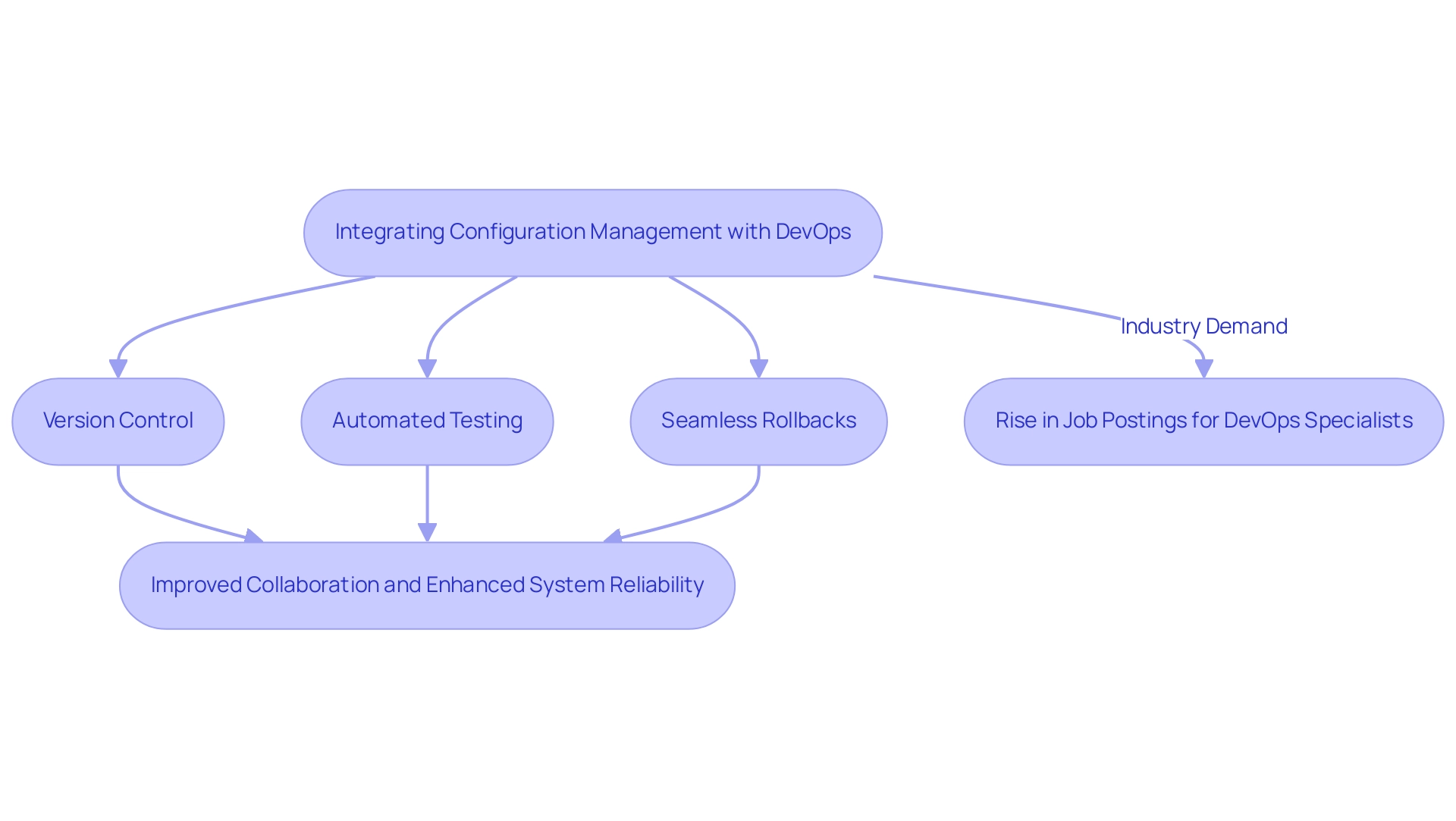
Addressing Challenges in Configuration Management Implementation
Applying system administration poses several obstacles, including opposition to adjustment, resource constraints, and inadequate instruction. Statistics indicate that around 70% of organizations face predictable challenges in change handling, status accounting, and verification processes. To navigate these issues effectively, securing stakeholder buy-in is essential.
This can be accomplished by expressing the concrete advantages of system organization, such as improved operational efficiency and fewer errors. A phased implementation plan can further facilitate the transition, allowing for gradual adoption that accommodates necessary adjustments along the way. Furthermore, investing in comprehensive training programs provides personnel with the vital skills to effectively use configuration management products.
Continuous feedback loops and iterative improvements are vital in keeping the implementation process aligned with organizational goals. For instance, in a recent merger case study, the alignment of accounting practices through audits and unified systems proved critical in ensuring financial consistency. As noted, "Align accounting practices in a merger to ensure financial consistency through audits, unified systems, and clear guidelines."
Such real-world instances emphasize the significance of overcoming resistance, illustrating that a culture of adaptability and success in system arrangement can be established.
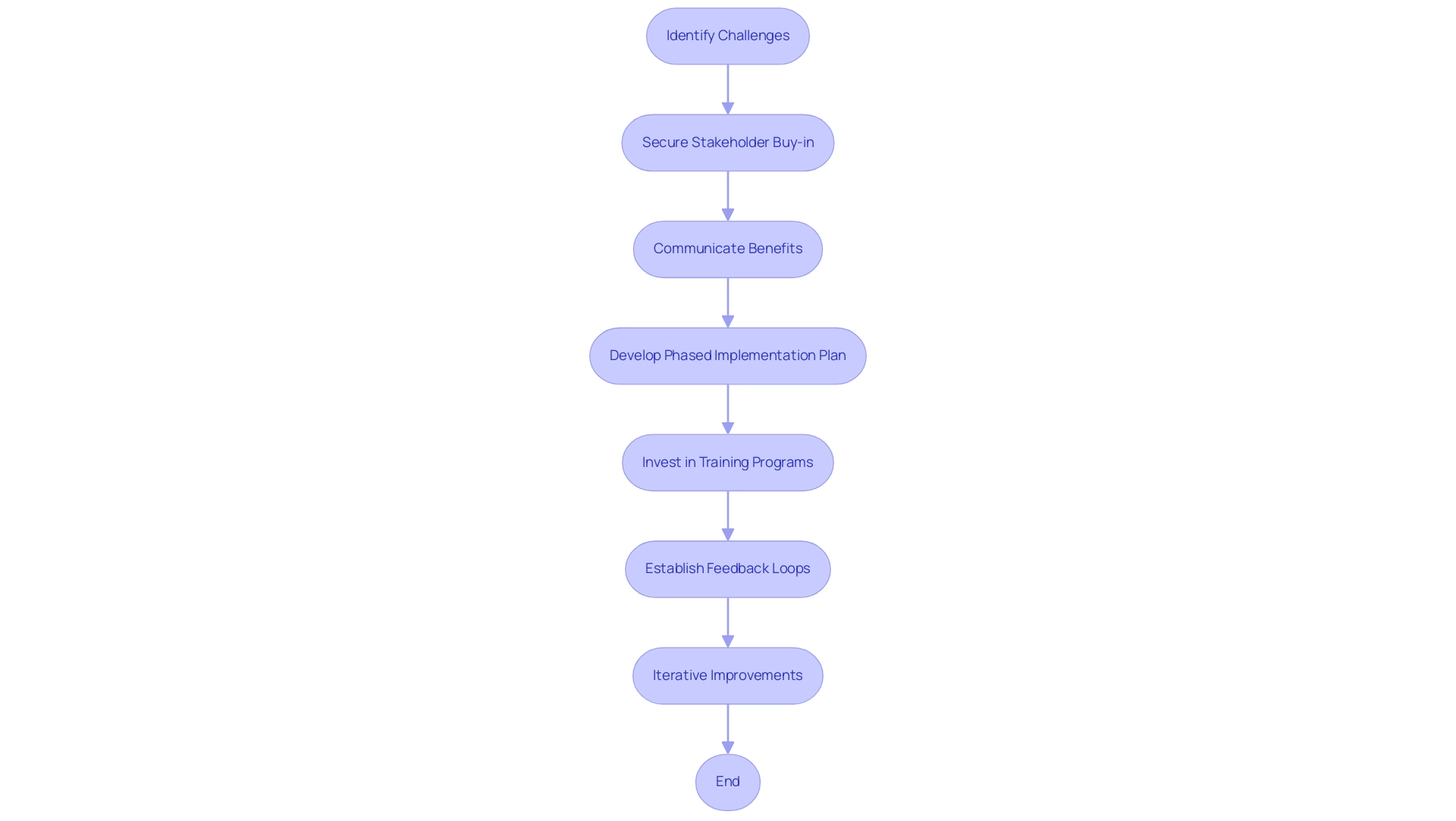
Measuring the Success of Configuration Management Practices
To effectively assess the success of configuration management products, organizations must establish key performance indicators (KPIs) that are aligned with their strategic objectives. Metrics play a crucial role in this evaluation, and several common indicators include:
-
Modification Success Rate: This metric assesses the percentage of modifications successfully implemented without resulting in incidents or downtime.
A higher rate signifies robust change management processes. -
Configuration Drift: Monitoring the frequency of deviations from the desired setup state is essential, as it highlights potential gaps in processes and compliance that could undermine system integrity.
-
Time to Recover: This indicator represents the average duration needed to restore settings following a failure or incident.
A shorter recovery time indicates the effectiveness of contingency plans and overall resilience. -
Audit Compliance Rates: This metric evaluates the success rate of passing audits related to setup oversight, reflecting adherence to established policies and industry standards.
In 2024, North America dominated the Setup Oversight Market according to Cognitive Market Research, underscoring the significance of effective setup oversight practices in the region. Consistently examining these metrics allows entities to identify areas for enhancement and evaluate the overall efficiency of their setup practices. As noted by Sharon Gloyn-Ham,
KPI standards vary; some aim for 95% accuracy, while others strive for 98.99% and achieve it.
Such ambitions highlight the significance of robust KPI frameworks and configuration management products in system setup. Significantly, upholding consistency between change oversight and the CMDB is a fundamental duty of the configuration supervisor, ensuring that alterations are precisely represented in the data repository.
By utilizing established standards and frameworks such as ISO/IEC/IEEE 15288 and ITIL, organizations can enhance their KPIs with configuration management products, resulting in improved process capabilities and better alignment with strategic technology objectives. The case study titled 'Standards and Frameworks for KPIs' suggests exploring various standards and frameworks for guidance on defining and assessing CM processes and activities, emphasizing that utilizing these established frameworks can enhance the effectiveness of KPIs in configuration management, leading to better process improvement and capability enhancement.
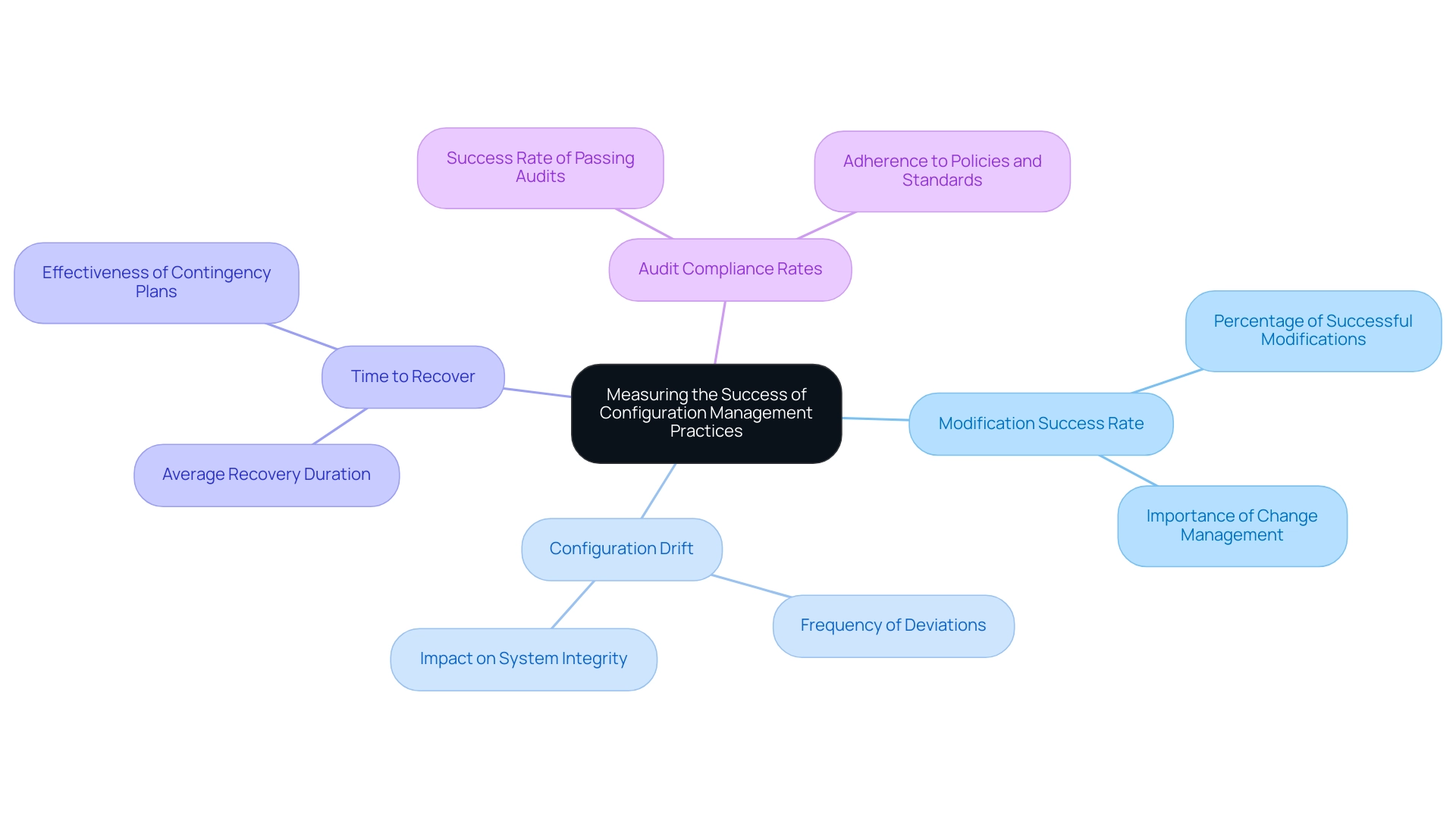
Conclusion
Configuration management stands as a fundamental pillar in today's technology-driven organizations, playing a critical role in ensuring system reliability, security, and operational efficiency. By adopting best practices such as:
- Establishing clear policies
- Leveraging automation
- Maintaining accurate documentation
- Integrating with DevOps methodologies
organizations can navigate the complexities of modern IT environments with greater agility and precision. The insights provided throughout this article underscore the importance of a structured approach to configuration management as a means to reduce risks and enhance service delivery.
As organizations face challenges in implementation, including:
- Resistance to change
- Resource limitations
it becomes essential to foster a culture that embraces adaptability and continuous improvement. By prioritizing training and stakeholder engagement, organizations can effectively overcome these hurdles, ensuring that their configuration management practices align with strategic objectives and industry standards.
Ultimately, measuring the success of configuration management through well-defined KPIs allows organizations to assess their effectiveness and make informed decisions for future enhancements. The journey towards robust configuration management practices is not merely a technical necessity; it is a strategic imperative that drives competitive advantage and operational excellence in a rapidly evolving digital landscape. Embracing these principles will empower organizations to thrive amidst the challenges of digital transformation, ensuring they remain at the forefront of innovation and service delivery.




